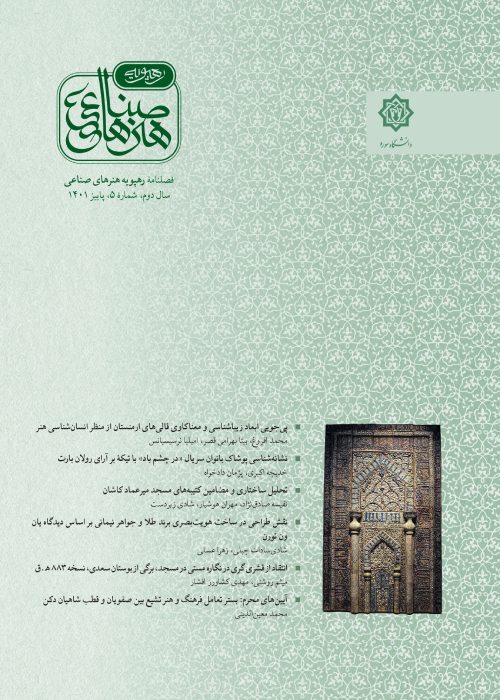Iconological analysis of the transformation of Alexander's painting and the talking tree from the patriarchal period to the Safavid period
Author(s):
Article Type:
Research/Original Article (بدون رتبه معتبر)
Abstract:
The legend of Alexander and the talking tree “Waqwaq” is one of the historical and legendary narratives that foretell the death of Alexander. The continuation of the story of “Alexander and the talking tree” in works of art, one of which is a non-Iranian but prominent king, and the other, a famous prophetic tree, makes this narrative very important. Therefore, it is necessary to do more analysis of the transformation process of this narrative. According to the purpose of the research, three paintings of Alexander in front of the talking tree (Waqwaq tree) from three different periods (Ilkhanid, Timurid, and Safavid) were selected.In terms of nature, this research is descriptive-historical, and in terms of purpose, it has a fundamental and qualitative approach. Necessary research information was collected using documentary methods and library resources. By investigating the metamorphosis in three selected paintings taken from the social, political, and cultural currents of that time, the development course and the decoding of the motif of “Waq and Iskandar” were discussed. The works were analyzed and explained in three stages based on the theoretical foundations of Erwin Panofsky. The research investigated the transformation process in three selected paintings influenced by the social, political, and cultural currents of the Mongol, Turkish-Mongolian, and Iranian periods. Among the most significant findings, was that Alexander the Great turned from a historical figure into a positive, sacred and legendary figure in the Islamic period. The rulers of different eras, including the Ilkhanid, Timurid, and Safavid periods, took advantage of this positive effect of Alexander and used it in the path of political goals and consolidation of power with the trick of positioning and iconography of their rulers in the role of Alexander. In other words, the transformation of the image of Alexander in the three images is in the direction of one goal, which is to establish the power and legitimacy of the rulers who do not have an Iranian identity. During the Safavid era, due to being Iranian, there was a need to show prominent and just sovereigns as mythical Iranian rulers in the form of images. Ilkhanid and Timurid rulers approach to this differently. They chose Islam as their religious discourse and supported its structures to confirm the legitimacy of their rule. We can see the evolution of the archetype of the tree of life into a sacred tree, its transformation into a talking tree in ancient Iran, and its transfer to the Islamic periods. Finally, this transformation led to the creation of the image of Waq, which appears in front of Alexander in the third picture. The depiction of the talking tree attempts to convey a message that has a place in the underlying semantic layers. This semantic conflict shows the instability of the rulers’ power, beautifully inaugurated in the paintings.
Keywords:
Language:
Persian
Published:
Journal of Industrial Arts, Volume:2 Issue: 2, 2022
Pages:
81 to 93
magiran.com/p2581371
دانلود و مطالعه متن این مقاله با یکی از روشهای زیر امکان پذیر است:
اشتراک شخصی
با عضویت و پرداخت آنلاین حق اشتراک یکساله به مبلغ 1,390,000ريال میتوانید 70 عنوان مطلب دانلود کنید!
اشتراک سازمانی
به کتابخانه دانشگاه یا محل کار خود پیشنهاد کنید تا اشتراک سازمانی این پایگاه را برای دسترسی نامحدود همه کاربران به متن مطالب تهیه نمایند!
توجه!
- حق عضویت دریافتی صرف حمایت از نشریات عضو و نگهداری، تکمیل و توسعه مگیران میشود.
- پرداخت حق اشتراک و دانلود مقالات اجازه بازنشر آن در سایر رسانههای چاپی و دیجیتال را به کاربر نمیدهد.
In order to view content subscription is required
Personal subscription
Subscribe magiran.com for 70 € euros via PayPal and download 70 articles during a year.
Organization subscription
Please contact us to subscribe your university or library for unlimited access!



